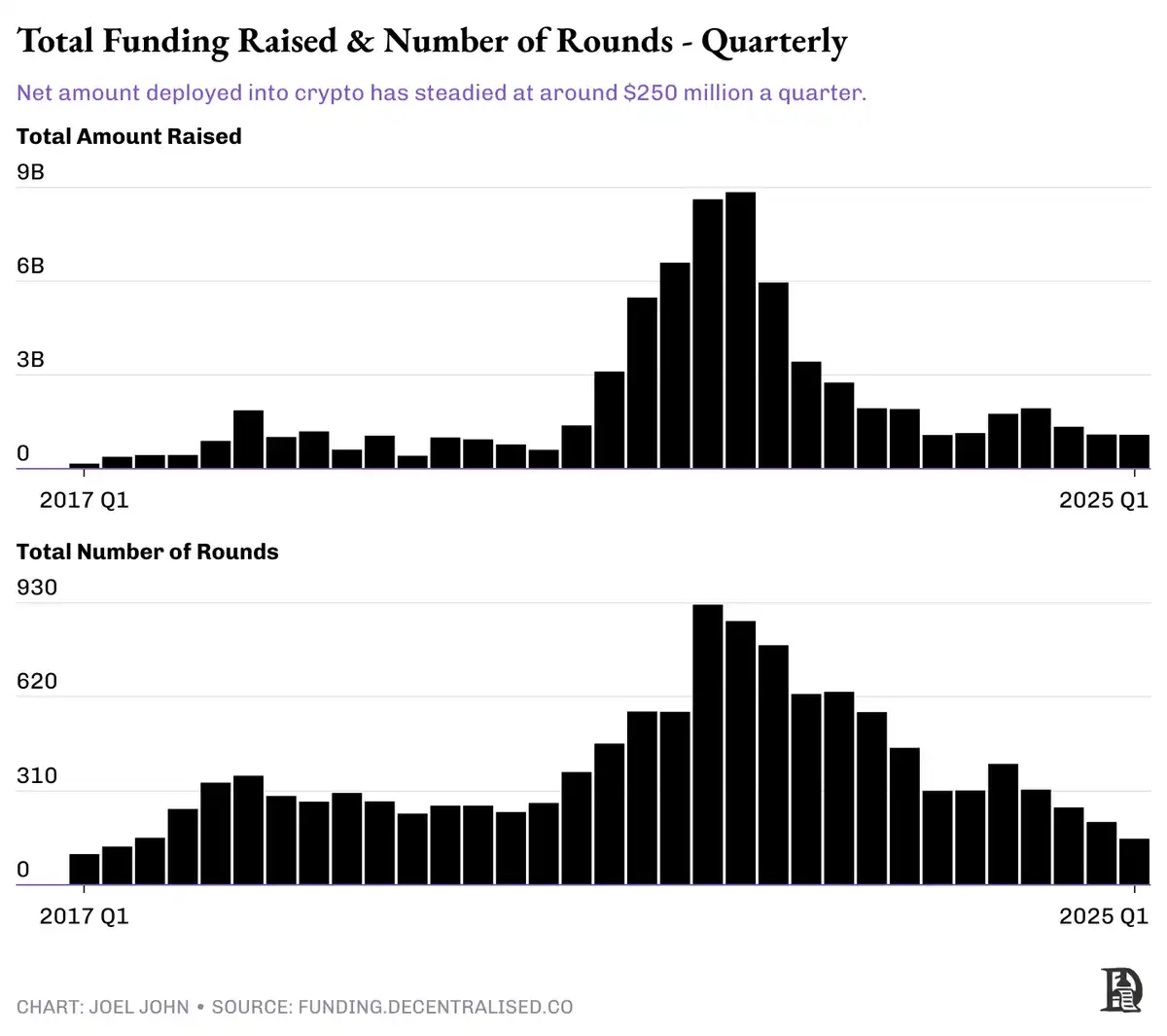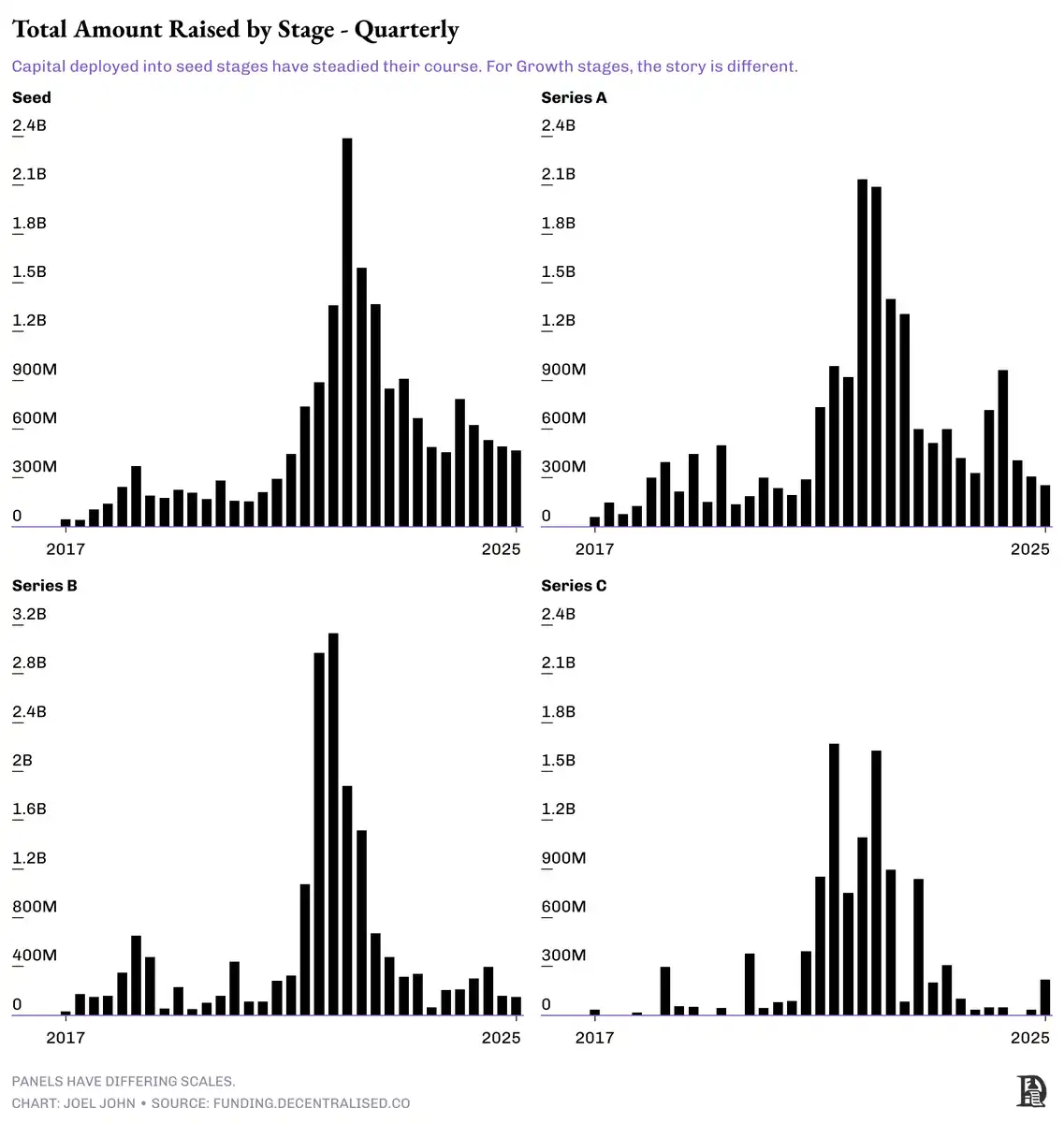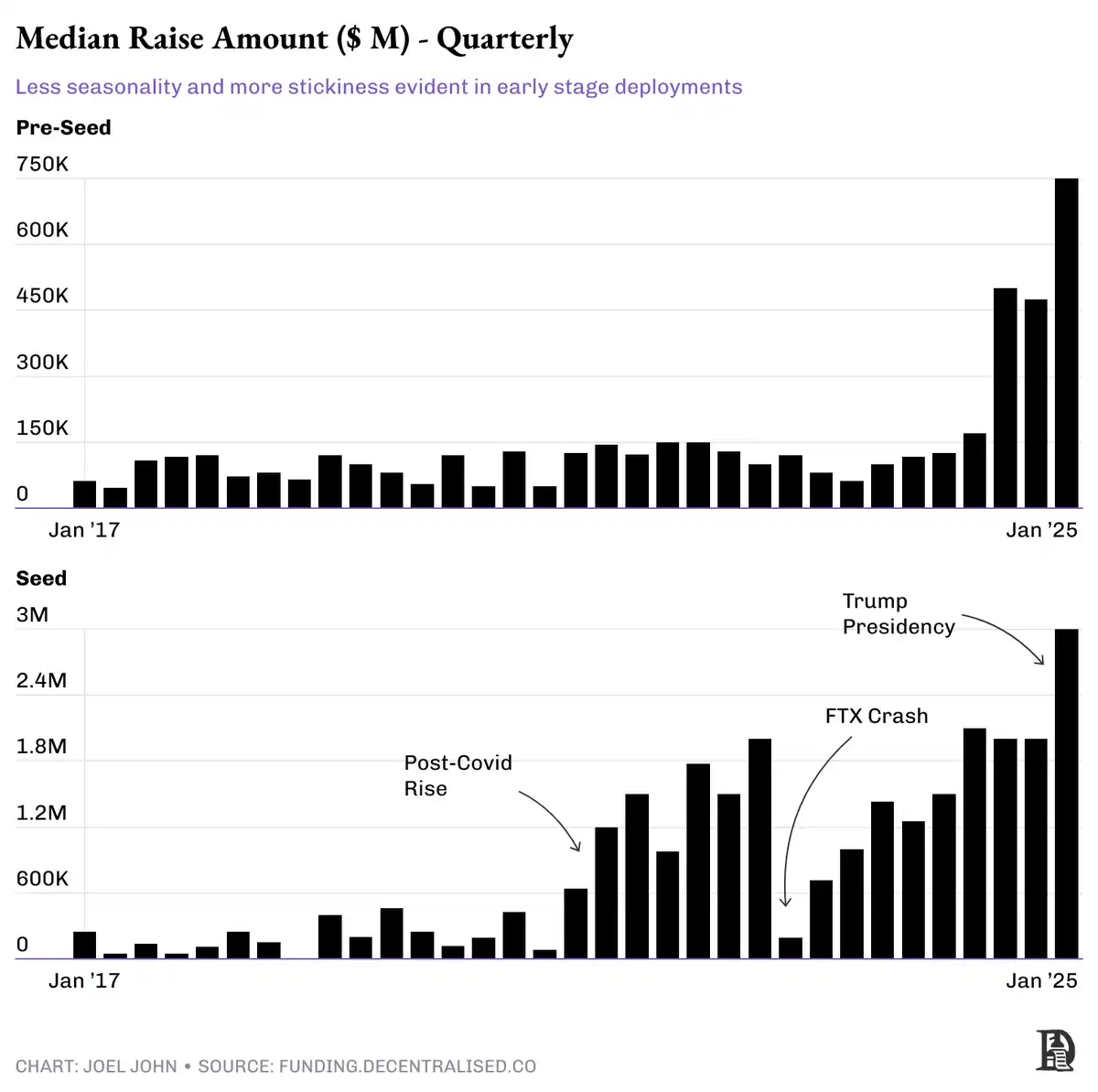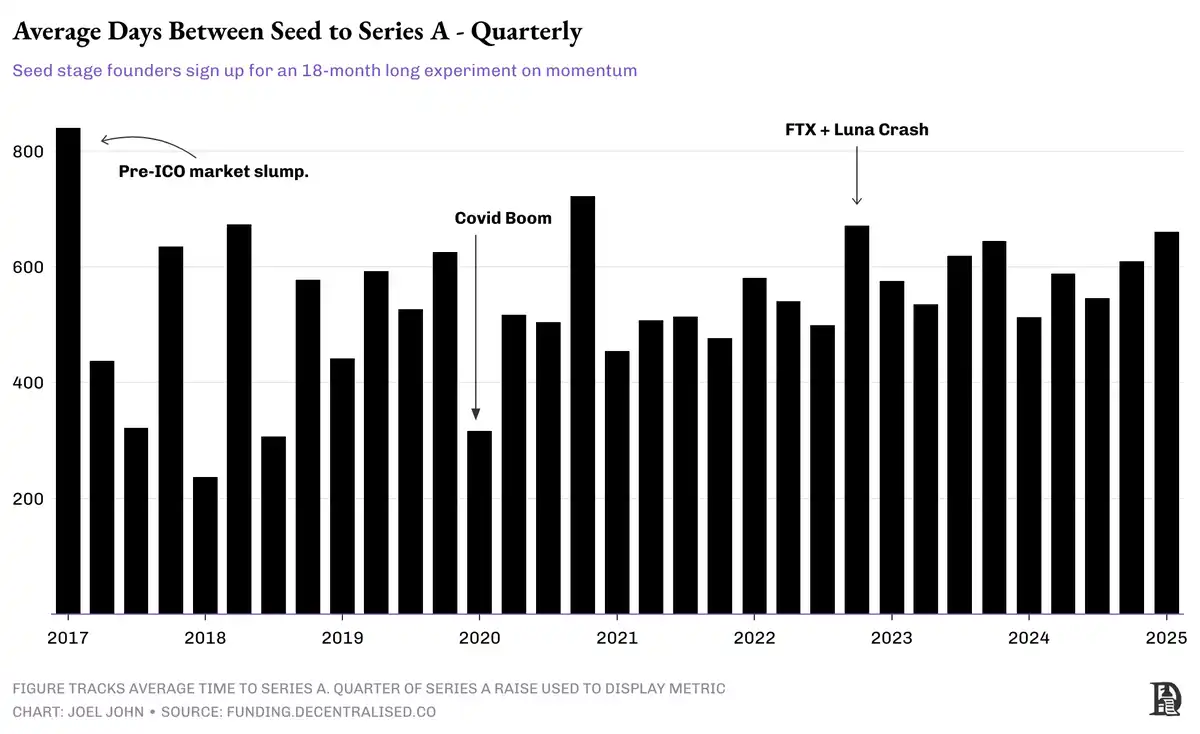Web3 Funding Status in Q1 2025
A rational market participant might assume that capital will ebb and flow, and like many things in nature, it has cycles. However, venture capital in the crypto space is more like a one-way waterfall - an ongoing experiment in gravity.
We may be witnessing the final stages of a return to more stable levels after a frenzy that began with the smart contracts and ICO wave in 2017 and accelerated in the low interest rate environment of the COVID era.

At its peak in 2022, venture capital investment in crypto reached $23 billion. By 2024, that number had plummeted to $6 billion. There are three main reasons for this decline:
1. The frenzy in 2022 led to excessive capital inflows - venture capital invested in many products, such as DeFi and NFT, at extremely high valuations in seasonal markets, but ultimately failed to bring expected returns. OpenSea was once valued at $13 billion, becoming the apex of the market bubble.
2. Difficulty in raising funds and disappearance of valuation premiums - In 2023/2024, many funds encountered obstacles in raising funds. And those projects that successfully listed on exchanges also found it difficult to reproduce the high valuation premiums of 2017-2022. Due to the lack of valuation improvement, it is difficult for funds to raise new funds, especially when many investors' returns are lagging behind Bitcoin.
3. AI replaces encryption as the "next hot spot" - large capital institutions turn their attention to AI, and the encryption industry loses the speculative craze and premium that it once had as the "most promising cutting-edge technology."
However, the deeper problem is that there are very few startups that can actually grow to Series C or Series D. Some people may think that the main exit method in the crypto industry is to list tokens on exchanges, but when most tokens go online and break the issue price, it becomes difficult for investors to exit. This is particularly evident when comparing the data of each round of financing.
Since 2017, only 1,317 of the 7,650 seed-round companies have successfully entered the A round, a promotion rate of 17%. Among them, 344 advanced to the B round, and only about 1% (±1%) advanced to the C round. The probability of the D round is only 1/200, which is comparable to other industries counted by @Crunchbase. But there is a special case in the crypto industry: many growth-stage companies will bypass the traditional financing path through tokenization. However, this reflects two core problems:
Without a healthy liquidity market for tokens, crypto venture capital will stagnate. This gap will be filled by liquidity market participants like @SplitCapital and @DeFianceCapital
If there are not enough companies that grow to the later stages and successfully go public, investors’ risk appetite will decrease.
Judging from the data of various financing stages, the market is sending the same signal: although the capital inflow of seed rounds and A rounds is basically stable, the active investment in B rounds and C rounds has dropped significantly. Does this mean that it is a good time to raise funds in the seed round? Not necessarily. The key is still in the details.

The data below shows the median amount of pre-seed and seed round financing each quarter. As you can see, the overall trend is steadily increasing. There are two points worth noting:
Pre-seed funding has grown significantly since the beginning of 2024.
The nature of seed rounds has changed over the past few years.
We observe that despite the decline in early-stage capital’s willingness to invest, startups are receiving larger pre-seed and seed rounds. The “friends and family rounds” of the past are now filled by early-stage funds, a trend that also affects seed rounds. Since 2022, seed rounds have increased in size to cope with rising labor costs and the longer time it takes for the crypto industry to achieve product-market fit (PMF). However, the decline in product development costs has offset this trend to some extent.
The increase in the amount of financing means that the company's valuation (or equity dilution) is higher in the early stages, which also means that higher valuation growth is needed in the future to bring returns to investors. In addition, the scale of financing has increased significantly in the months after Trump's election. This may be related to the change in the fundraising environment for fund management partners (GPs) after Trump took office-the interest of fund funds (FoF) and traditional allocators has increased, which has put the early market into a "risk preference" mode.

What does this mean for founders? There is more money being raised in early-stage Web3 rounds than ever before, but it is concentrated in fewer founders, with larger rounds and requiring companies to grow faster than in previous cycles.
As traditional liquidity channels (such as token issuance) are drying up, founders need to put more effort into demonstrating their credibility and the possibilities their business can bring. The era of "50% discount, a new round of high valuation financing in two weeks" is over. Funds can no longer profit by "driving up valuations", founders can no longer easily raise funds, and employees' vested tokens no longer enjoy the bonus of rapid appreciation.
One angle to verify this trend is the capital flow rate. The chart below shows the average time it takes for startups to go from seed round to round A. The lower the value, the faster the capital flow rate, that is, investors are willing to invest more money before the company matures and support new seed round companies with higher valuations.
Another key factor is how public market liquidity affects private markets. Investors tend to increase their investments in private markets when public markets pull back. For example, during Q1 2018, the market fell sharply and Series A funding dropped significantly. The same situation was repeated in Q1 2020, when the market crashed due to the COVID-19 pandemic. For investors with capital, the appeal of investing in private markets increases when public market investment opportunities decrease.

After the collapse of FTX in Q4 2022, the market's risk appetite dropped significantly. Unlike previous cases where private market financing increased during market corrections, this crash directly destroyed the attractiveness of the crypto industry as an asset class. Prior to this, several large funds had invested huge amounts of money in FTX's $32 billion valuation financing, but ultimately lost all their money. As a result, investors' interest in the entire industry has dropped significantly.
After the collapse of FTX, funds began to concentrate on a few leading companies. These companies became "kingmakers" and dominated the capital flow of the market. Most of the LP (limited partner) funds flowed into these head funds, and they tended to deploy funds in later projects because they could absorb more capital. In other words, the financing environment for start-ups has become more difficult.
The future of crypto venture capital?
I have been observing this data for the past six years, and each time I have come to the same conclusion - it will become increasingly difficult to raise funds for startups. I may not have realized at the age of 24 that this is how the industry evolves. Market frenzy will attract a lot of talent and capital, but as the industry matures, it will inevitably become more difficult to raise funds. In 2018, projects can raise funds as long as they are "on the blockchain"; by 2025, investors are more concerned about profitability and product market fit (PMF).
As token liquidity decreases, venture capitalists have to re-evaluate liquidity and capital deployment strategies. In the past, investors expected to get returns through tokens within 18-24 months, but now this period has been extended. Employees also need to work harder to get the same number of tokens, and these tokens are often traded at lower valuations. This does not mean that there are no profitable companies in the industry, but like the traditional economy, only a few companies will eventually absorb most of the economic value.
Will venture capital die? From a playfully pessimistic perspective, maybe. But the reality is that Web3 still needs venture capital.
The infrastructure layer is mature and can support large-scale consumer applications.
Founders have experienced multiple market cycles and have a deeper understanding of how the industry works.
Internet coverage is expanding and global bandwidth costs are falling.
The development of AI is expanding the possibilities of Web3 applications.
Together, these factors create an unprecedented period of opportunity. If the venture capital industry wants to “make venture capital great again,” then they need to focus on the founders themselves, not how many tokens they can issue. Today, capital allocators are more willing to spend their time supporting founders who have the potential to dominate the market. This change is the growth process of Web3 investors from “When will the coin be issued?” in 2018 to “Where is the limit of the market?” in 2025.






